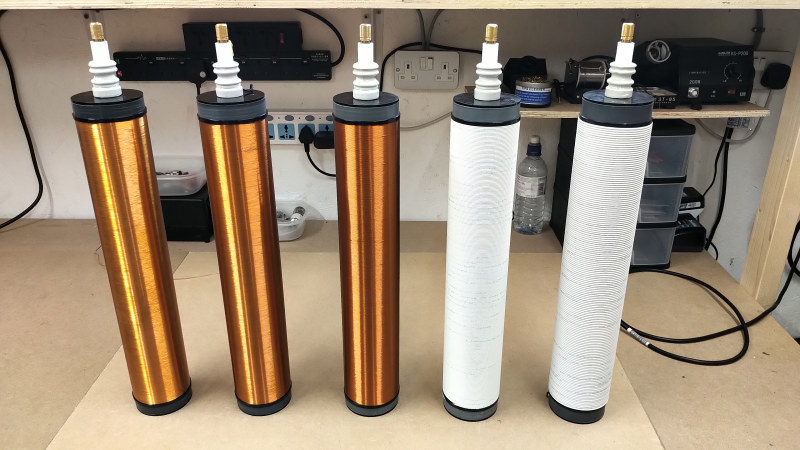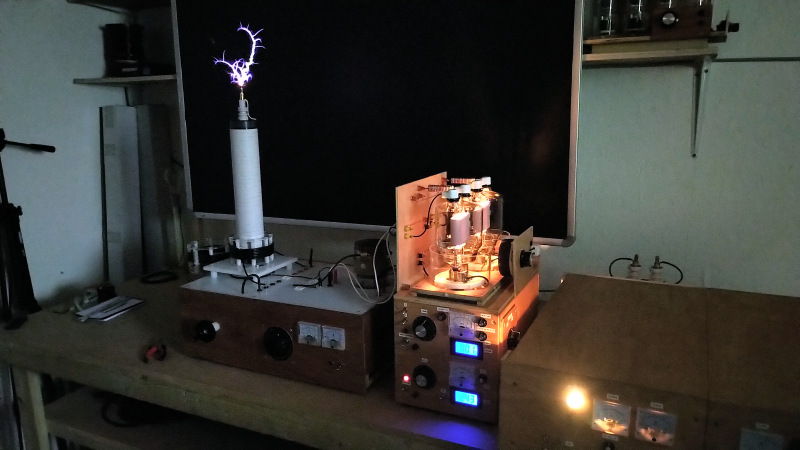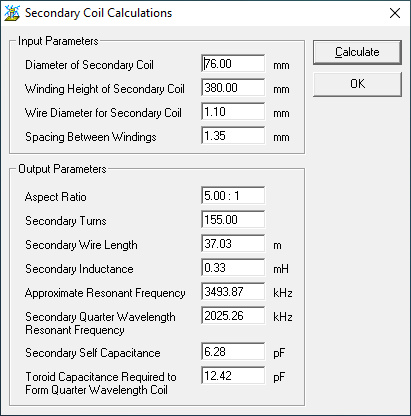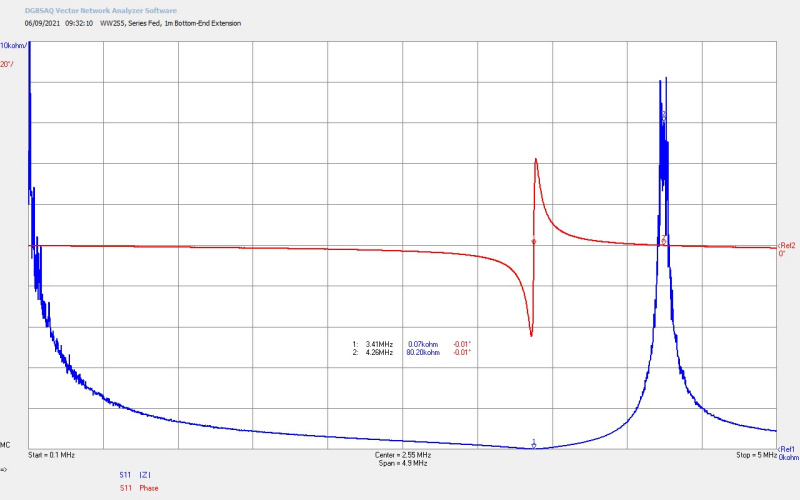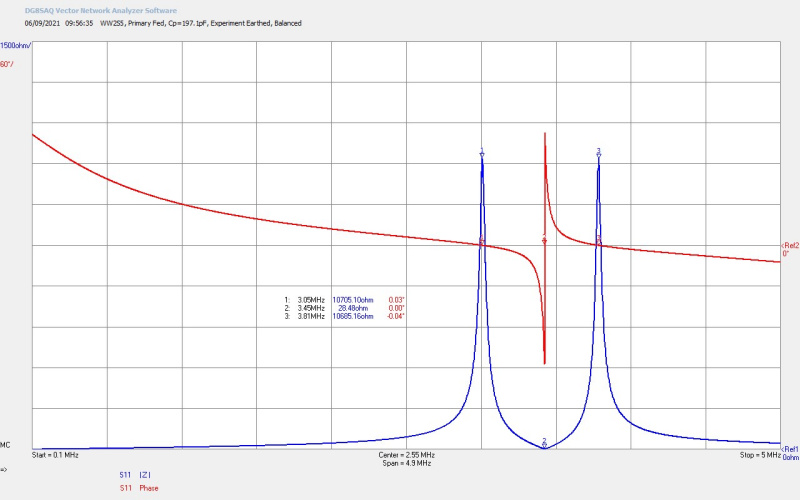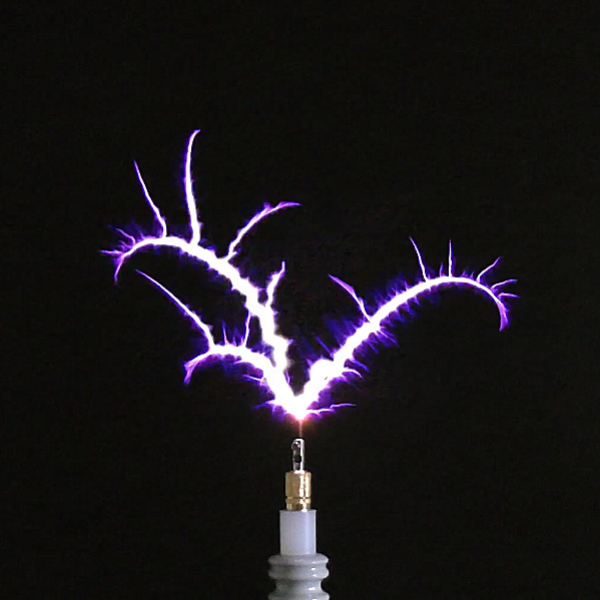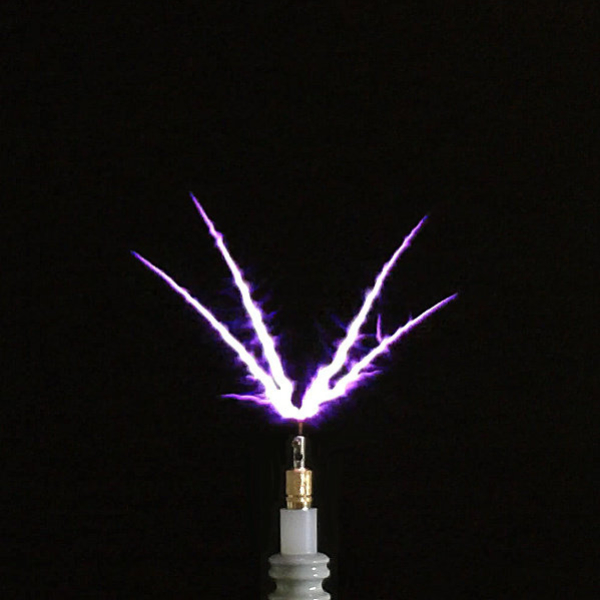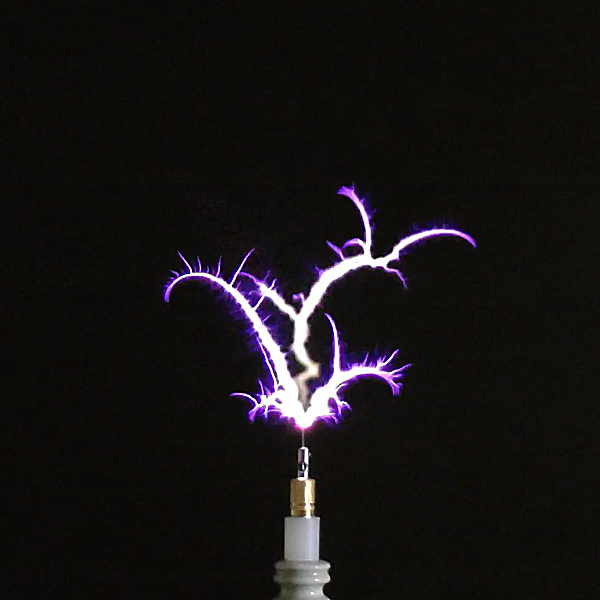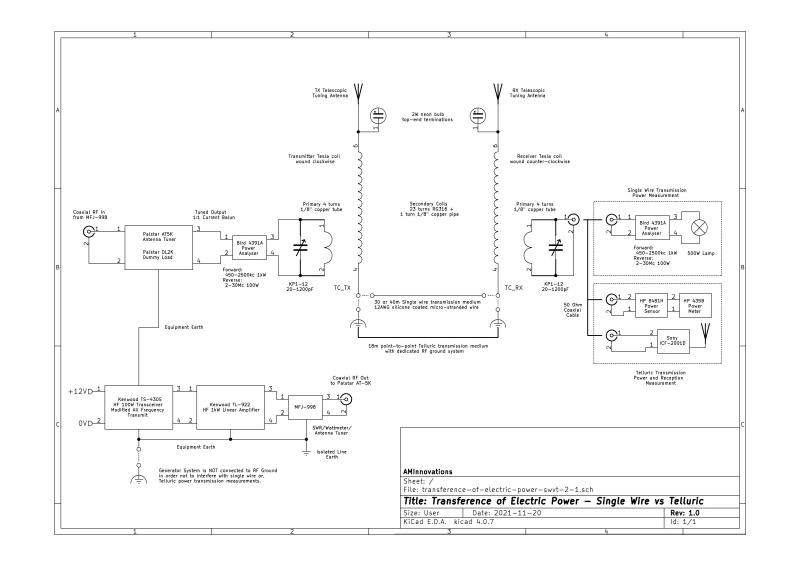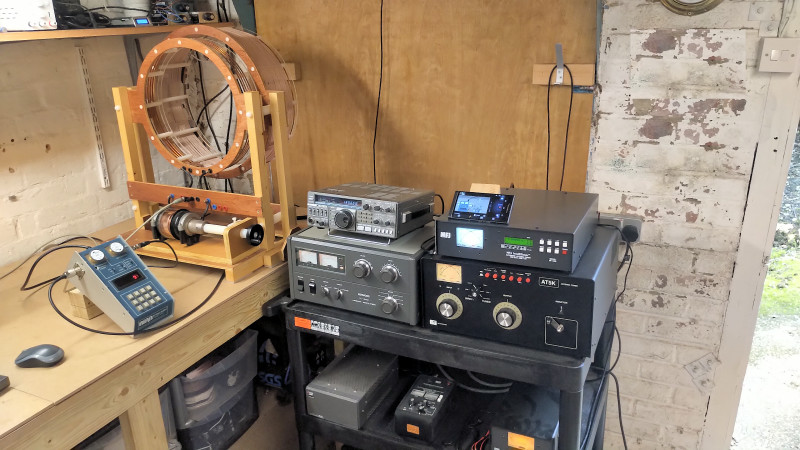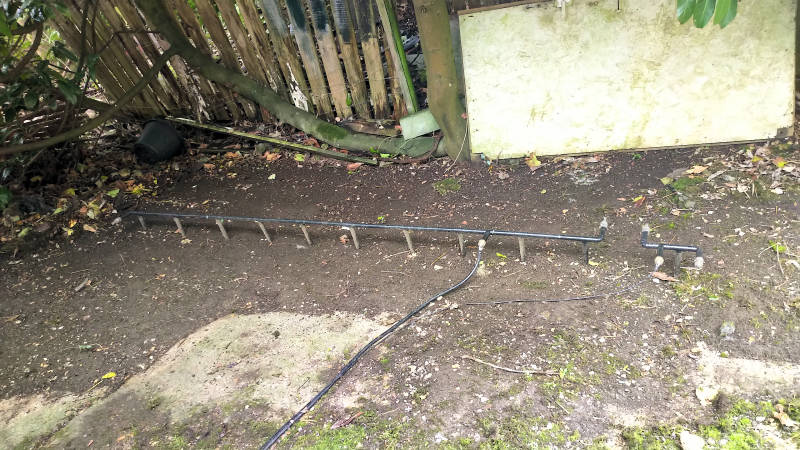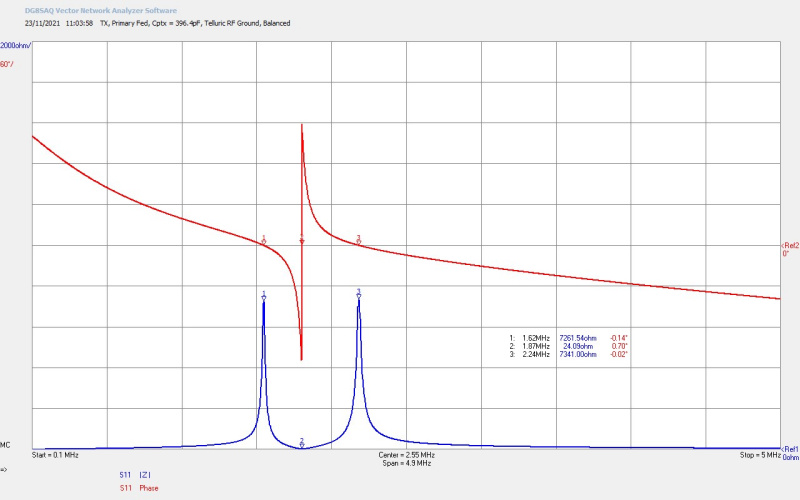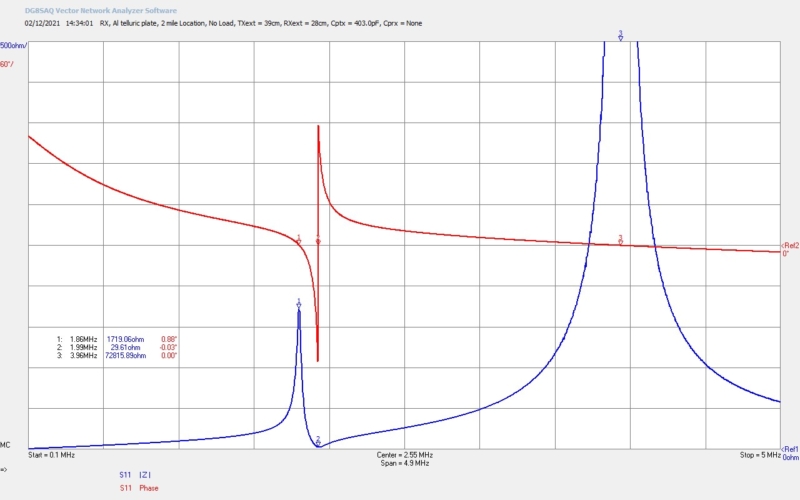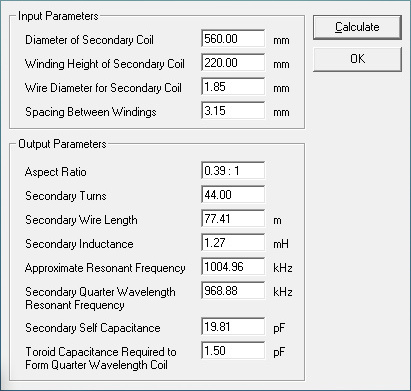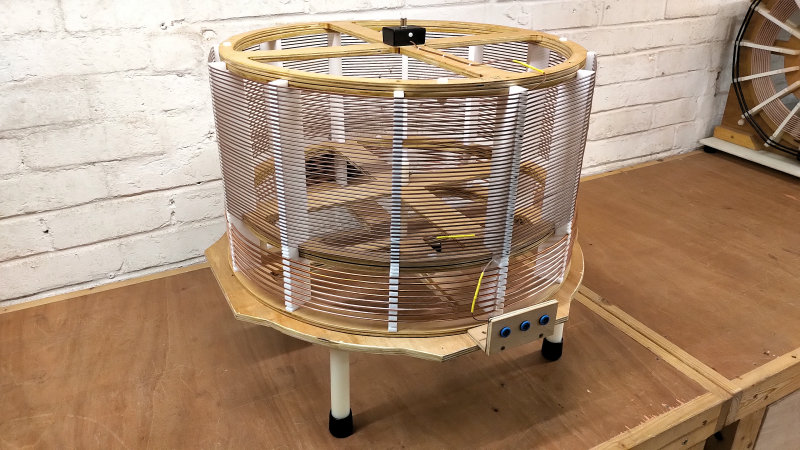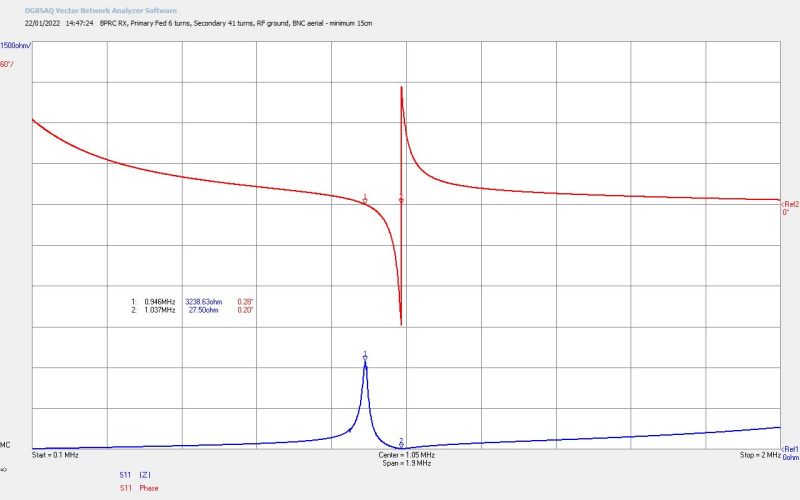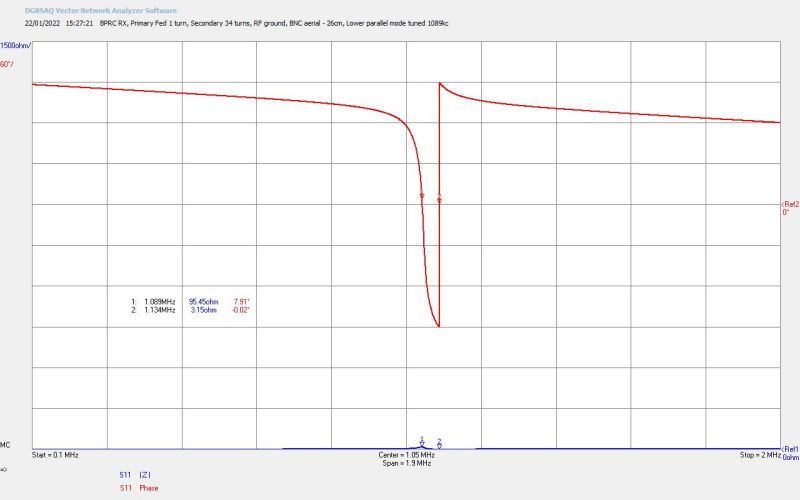In this follow up experiment in the Wheelwork of Nature series we take a look at vibration, frequency, and discharge form that results from a set of Tesla coils designed to cover an operating frequency range between 300kc and 4Mc. If you have not done so already I recommend reading or reviewing the first experiment in this series The Wheelwork of Nature – Fractal “Fern” Discharges, which will set the basis for this current experiment. In the original experiment a range of experimental variations were tested in order to identify the origin of the fractal “Fern” discharge form, which is a distinct and significant departure from the discharge form normally observed in Tesla coils constructed using a basic standard design format, and constructed with readily available materials and processes. Variations to the experiment included, changing the matching and tuning of the Tesla coil, the excited resonant mode, the generator waveform, the type of vacuum tube used as a generator, and a top-load on the Tesla coil. The only significant variation to the discharge form was noted between the upper and lower parallel resonant modes of the Tesla coil, and hence it was concluded that frequency, or more correctly vibration, of the Tesla secondary coil was key to the nature and form of the fractal “fern” discharge.
The original coil was theoretically designed with a series resonant mode frequency of the secondary ƒSS ~ 3.5Mc in the 80m amateur radio band, and was subsequently measured using a vector network analyser to have a series fed fundamental resonant frequency ƒSS = 3.44Mc. When this was combined with a primary coil and RF ground it was found to reduce to ~ 3.18Mc. The upper and lower parallel resonant modes were found to be around 2.7Mc and 3.4Mc. The generator used was a basic class-C Armstrong oscillator using a single GU5B vacuum tube, and dual 883C vacuum tubes in the variation generator. This form of generator will oscillate readily at the upper or lower resonant parallel modes and can be tuned over a frequency band using a vacuum variable capacitor as a parallel tank capacitor in the primary circuit. This gave a tuned range from low end of the lower parallel mode at ~ 2.4Mc to the high end of the upper parallel mode at ~ 3.6Mc. Across this entire tuned range the discharge form was the fractal “fern”. The only significant variation was at the upper parallel mode, where the fractal “fern” appeared more compact, tightly formed, and with more dense secondary and tertiary tendrils.
In this next experiment the exploration of vibration and frequency is extended across a much wider range by using a set of Tesla coils that are designed on the same geometry, with the same materials, but with different wire type and gauge, and hence the fundamental series resonant mode changes with the wire length. Originally five coils were designed and constructed, with series resonant mode frequencies of ƒSS ~ 357kc, 570kc, 1013kc, 2068kc, and the original at 3494kc. The general design characteristics of the coils, key measured, operating and tuning characteristics are summarised in figures 1 shown below, and explained in detail later in this post.
In practise, when using a self-tuned feedback oscillator as the generator, the lower frequency coils tend to preferentially oscillate at the 2nd or 3rd harmonic frequency around 1Mc, where the gain of the vacuum tube generator is higher, and the capacitive loading in the primary is lower. Increasing the tank capacitance to tune the fundamental of these lower frequency coils, significantly capacitively loads the vacuum tube generator reducing the Q of the system dramatically, and making it very difficult to oscillate in class-C mode. Ideally the two lowest frequency coils would be driven directly at the series resonant mode frequency ƒSS, however this drive strategy is not best suited to the scope of this experiment where variable frequency adjustment during operation is preferred. As a result of this, and without wanting to significantly change the generator and matching for this experiment from the previous one, the three upper frequency coils only are demonstrated in the video for this experiment. In practise that proved to be more than adequate to demonstrate the transition of the discharge form, from the fractal “fern” discharge, to the more standard “swords” form, which is commonly observed for a standard Tesla coil design when driven by a vacuum tube generator.
The video experiment demonstrates and includes aspects of the following:
1. Three secondary coils based on the same geometry, dimensions, and construction, with different wire gauge and hence wire length, producing a different fundamental series resonant frequency in each secondary coil.
2. A standard vacuum tube Tesla coil generator (VTTC), operated in CW mode using a pair of 833C vacuum tubes (VT) arranged in parallel as a tuneable class-C Armstrong oscillator.
3. The tube power supply (HV & Plate) configured for 2 series transformers with a nominal output of 4.2kV @ 0.8A, 3.3kVA, HV bridge rectified, and with 25nF 25kV blocking capacitor at the output, and operated up to 3kW line input power.
4. Secondary coils with nominal fundamental series resonant frequencies of ~ 3.5Mc, 2.0Mc, and 1Mc, could be easily exchanged, tuned, and matched to the VT generator.
5. The 3.5Mc coil operated over a range of 2.4-3.3Mc, shows the fractal “fern” discharge over the entire frequency band. A tighter and denser fractal “fern” was observed across the upper parallel mode.
6. The 2.0Mc coil operated over a range from 1.5-2.3Mc, shows the fractal “fern” discharge at the upper parallel mode, and the “swords” discharge at the lower parallel mode.
7. The 1.0Mc coil operated over a range from 970kc-1.4Mc, shows the “swords” discharge over the entire frequency band.
8. The transition from fractal “fern” to “swords” occurs between 1.8-2.0Mc, where the “sword” discharge retains slight curvature until frequencies < 1.5Mc.
9. Conjecture that the variation of discharge form may result from the changing vibrational qualities within the relationship between the dielectric and magnetic fields of induction at different frequencies, and hence part of the underlying principles and mechanisms within the Wheelwork of Nature.
Principle of Operation and Construction of the Experimental System
The experimental apparatus uses the same high voltage plate tube supply from the pervious experiment, configured in the same way with two series transformers, bridge rectified, and with a 25nF blocking capacitor at the generator output to protect the semiconductors of the bridge rectifier. The design, construction, and operation of this high voltage tube supply is covered here Tube Power Supply – High Voltage & Plate. The generator itself uses the dual 833C tube board with the tube supply heater unit as an class-C Armstrong oscillator, both of which were used in the variation experiments in the first part of this series, and are covered in detail in Tube Power Supply – Heater, Grid & Screen. The dual 833C tubes proved to be more flexible over a wider frequency band than the single GU5B based generator used in the primary Wheelwork of Nature experiment. The principle of operation of the generator, setup, operating characteristics, and schematic are covered in detail in the original post here The Wheelwork of Nature – Fractal “Fern” Discharges.
The feedback coil for the Armstrong oscillator now has variable windings, and is positioned offset from the secondary coil. The variable turn geometry of the feedback coil facilitates more accurate and optimal tuning of the generator based on the secondary coil used, and the lower or upper parallel mode being explored. Too much feedback to the generator will distort the drive waveform away from a clean sinusoidal, and too little feedback makes the oscillation unstable, and with a reduced gain in the generator. The optimal adjustment was to establish oscillation with the maximum number of turns on the feedback coil which produced a clean sinusoidal oscillation in the primary tank circuit. The number of turns varied for each secondary coil, and for the upper or lower parallel mode for each coil. With the correct number of turns set on the feedback coil, the generator match to the experiment was fine adjusted using the grid bias rheostat to produce maximum output from the secondary, with minimum average grid current.
Figures 2 below show a range of pictures of the experimental apparatus used in the video experiment, along with the measurement equipment, and some of the key construction details that vary from the original experiment.
Figures 3 below show some of the operation highlights during the experimental running, and the typical output from the measurement equipment, including generator driving frequency and waveform.
Again Tccad 2.0 was used for a rapid and approximate indication of the electrical and resonant characteristics of the secondary coils, the detailed results of which are shown below in figure 4. The wire selected for coil 1 and 2 is a good quality silicone coated multi-stranded conductor, the silicone coating being very good both thermally, and as an insulator to prevent breakouts and breakdown from the upper turns of the coil to the lower ones. For secondary coils 3, 4, and 5, a good quality polyester-polyamide coated magnet wire was used, with the final wound coil being further coated with high-temperature lacquer. The final lacquer coating is used to keep the windings in place, and add some additional breakdown insulation protection.
Small Signal AC Input Impedance Measurements
The small signal ac input impedance Z11 for each Tesla coil was measured directly using an SDR-Kits VNWA vector network analyser, as used on many experimental pages on this site. Figures 5 show the series-fed free resonant characteristics of the five Tesla secondary coils.
To view the large images in a new window whilst reading the explanations click on the figure numbers below.
Fig 5.1. Shows the series fed input impedance Z11 for Tesla coil 1, design ƒSS = 3.49Mc. The measured fundamental series resonant mode ƒSS @ marker M1 = 3.41Mc, and with a 1m single wire extension at the bottom-end of the negative terminal of the VNWA. The parallel mode ƒSP @ M2 = 4.26Mc, and is characteristic of a standard Tesla coil design where the parallel mode is above the series mode when the secondary is on its own in a series-fed configuration. The characteristics of Tesla coil and TMT input impedance Z11 is covered in detail here Cylindrical Coil Input Impedance – TC and TMT Z11. The large and well defined phase change at M1 shows the high quality factor Q of the coil, which mostly occurs when the geometry of the turns of the coil are not too tight, and have adequate spacing between them, in this case the distance between turns is ~ 1.35mm, the thickness of the silicone wire cladding, and the diameter of the wire is ~ 1.1mm. Geometry of Tesla coils and there design is covered in detail here Tesla Coil Geometry and Cylindrical Coil Design.
The coil is purely resistive at both the resonant modes ƒSS and ƒSP. At the series mode ƒSS reaches a minimum at ~ 70Ω, and a maximum of ~ 80kΩ at the parallel mode ƒSP. Both series and parallel modes are particularly useful depending on what type of generator is being used to excite the Tesla coil. A tuned linear amplifier, spark gap generator, or solid state inverter are best suited to driving the series mode, and a series feedback oscillator such as a class-C Armstrong oscillator is suited to drive at the parallel mode. With correct matching and tuning it is possible to couple significant power into the Tesla coil through either the series or parallel modes. The parallel mode allows for frequency adjustment dependent on how the tank circuit in the primary is setup, which is particularly useful for this experiment where a range of frequencies can be tuned dynamically during operation using a vacuum variable capacitor. If secondary feedback is arranged through a pick-up coil to the vacuum tube generator the parallel mode can be tracked dynamically with little additional tuning required during operation, other than at the band-edges where the grid-bias will need adjusting, and the feedback coil turns optimised.
At the series mode, frequency can also be adjusted by changing the wire-length at the top-end of the secondary coil. This is best affected using a telescopic aerial or other adjustable wire length, but is not so practical to adjust during operation without re-tuning the generator to the new frequency. Driven either at the series mode or the parallel mode, transmission mode conversion can be accomplished between the driving primary circuit, and the cavity of the secondary coil formed with the single-wire or transmission medium connected to the bottom-end of the secondary coil. In principle, power in the TEM transmission mode in the primary circuit, can be transferred and transformed to the LMD transmission mode in the cavity of the secondary coil. The cavity in principle can be made to extend over very large distances, presenting the possibility for power transfer at very low-loss over very large distances in the far-field, and many times the wavelength of excitation at the generator. A second tuned Tesla coil in the cavity of a TMT system transforms the LMD mode back to the TEM mode in the receiver primary. The transfer of power, which accompanies the transformation of transmission mode from the cavity in the secondary to the primary circuit of the receiver, can then be used to do work in the load. It is interesting to note that the frequency of the LMD mode in the cavity is not the same as the frequency of the TEM modes in the primary of the transmitter and receiver.
Fig 5.2. Here secondary coil 2 has series mode ƒSS = 2.03Mc, and parallel mode ƒSP = 2.52Mc. Compared to coil 1 this is more tightly wound, with reduced conductor spacing and more turns, and hence the Q has reduced significantly, as can be seen in the reduction of the magnitude of the phase swing at M1. Both coils 1 and 2 are on the same magnitude and phase scales, and the phase reduction for this coil is a factor of ~ 2. The longer wire length has also considerably increased the coil resistance at the series and parallel modes, RSS = 160Ω, and RSP = 122kΩ. The second odd harmonic at 3λ/4 is just visible at M3 @ 4.97Mc. This coil when combined with the primary in the video experiment shows the transition between the upper parallel mode and the fractal “fern” discharge, and the lower parallel mode which shows the “swords” discharge with an additional slight curvature. However, in the series-fed Z11 small signal impedance analysis there is nothing obvious that suggests some different electrical characteristic or feature that may be responsible for this dramatic transition from one discharge form to the other. It is worth considering at this point as to whether interaction between harmonics has any bearing on the discharge form. As the fundamental resonant frequency goes down through designed wire-length the harmonic frequencies become progressively closer which makes it more possible for energy to be transferred between the harmonics through the non-linear nature of the discharge.
Fig 5.3. Shows secondary coil 3 and the final coil used in the video experiment. Here the 2nd, 3rd, and 4th odd harmonics are very clearly defined. The phase scale has been expanded from 20°/div to 10°/div to show clearly the phase swing as it collapses with reducing Q of the coil, much reduced wire spacing, increased turns, and hence increased series coil resistance. Operation of this coil was still at the fundamental resonant modes rather than at harmonics, and when combined with the primary, (shown in figures 6), result in the parallel mode operating points used in the video. The series mode ƒSS = 1.10Mc with RSS ~ 370Ω @ M1, and the parallel mode ƒSP = 1.37Mc with RSS ~ 191kΩ @ M2. Harmonic frequencies extend at nλ/4 where n is an odd number, and with progressively reducing Q, and hence have a smaller and smaller impact as frequency increases. This coil clearly displayed the straight “swords” discharge at both the upper and lower parallel modes of operation, the slight curve was no-longer present and each discharge streamer projected straight outwards from the breakout point at the top-end of the coil. Streamers continued to be white and “hot” consistent with the generator drive which is at a maximum capped voltage defined by the two series transformers driven by the SCR, and current rich controlled by the “on” phase of the SCR power control.
Fig 5.4. and 5.5. Show the two lower frequency coils 4 and 5 that were not demonstrated in the video experiment. In both Z11 measurements there are a very large number of harmonics, and the phase scale has been expanded again from 10°/div to 5°/div to reflect the collapsing Q of the coils, the rapidly rising series resistance from thinner gauge wire of many turns, and hence much longer wire lengths. Lower frequency Tesla coils like these tend to oscillate at a harmonic frequency when driven by a feedback oscillator using the parallel mode resonant frequency. In Fig. 5.4 it can be seen that the Q of the second odd harmonic at M3 is actually higher than the fundamental at M1. In this case the coil is more likely to stably oscillate at ƒSP2 the second harmonic parallel mode when driven using a series feedback oscillator. This will become clearer when we look at the parallel mode points when combined with the primary in figures 6.
Consequently many lower-frequency standard Tesla coils presented on the Internet tend to oscillate stably at the 2nd or 3rd harmonic when driven by a series feedback oscillator. To drive these two coils at their series fundamental resonant modes a fixed frequency linear oscillator or amplifier needs to be used where the frequency can be selected and fixed, and the generator is specifically matched at this fixed frequency, and then considerable power can be stably transferred to the secondary. This generator is more complicated than the series feedback tube oscillator, and required more setup, tuning, and matching to run at the equivalent power used in this experiment. For compatibility and simplicity with the previous Wheelwork of Nature experiment, I have kept the generator the same as before and avoided any additional complexity in the experiment, and its possible interpretation. I will look to make a video of these two low frequency coils driven by this form of fixed frequency generator in a subsequent experiment.
Figures 6 show the balanced parallel modes for each secondary coil when combined with the primary and tuned to balance using the primary circuit tank capacitor Cp. The primary tank capacitor is based on a KP1-4 10kV vacuum variable capacitor with range 20-1000pF. For the lower frequency secondary coils 3, 4, and 5, it was necessary to add a parallel static capacitor to the variable capacitor in order to increase the tank capacitive loading, and hence achieve balance of the upper and lower parallel modes.
To view the large images in a new window whilst reading the explanations click on the figure numbers below.
Fig 6.1. Here secondary coil 1 has been added to the primary circuit shown in Fig. 1.5. The primary tank circuit is formed by the primary coil, the vacuum variable capacitor, and any additional fixed loading capacitance. When tuned correctly the parallel mode from the secondary coil occurs at the same frequency as the parallel mode from the primary coil. When the coils are coupled energy is exchanged backwards and forwards between the two parallel modes which causes “beat” frequencies, and a frequency splitting of the two parallel modes. The degree of splitting depends primarily on the magnetic coupling coefficient k, the Q of the two coils, and the geometry of the coils. The parallel mode from the primary results from the self-resonance of the primary coil, which is typically for the coil shown, around 30-50Mc for the fundamental series mode. The parallel mode of this self-resonance is at a much lower frequency than the series mode, and can be tuned down to even lower frequencies by addition of CP, the primary circuit tuning capacitance. The splitting of the two parallel modes from the primary and secondary results in the lower and upper parallel resonant modes of the Tesla coil, and can be driven and tuned directly when using a series feedback oscillator type generator. Tesla coil resonance modes are covered in much more detail here Cylindrical Coil Input Impedance – TC and TMT Z11.
When the parallel modes are tuned using CP to a point where the magnitude of their impedance is equal, and the phase angle of their impedance is zero, then the balanced mode is achieved. This condition balances the two parallel modes of the Tesla coil either side of the series fundamental mode, and has been found in some cases to be an optimum driving condition for a Tesla coil for certain different types of phenomena including, High Efficiency Transference of Electric Power in the close mid-field region, balanced TMT setup for LMD transmission experiments in Transference of Electric Power, and the equilibrium initial condition for experiments in the Displacement of Electric Power. This typical balanced mode for a Tesla coil is shown in this figure, where the fundamental series resonant mode is at M2 @ 3.45Mc, and the lower and upper parallel modes are at M1 @ 3.05Mc, and M3 @ 3.81Mc, and the primary tank capacitance CP was set at 197pF to achieve this balanced point. At all of these three resonant modes the phase of the impedance is 0 degrees, showing the input impedance seen by the generator is entirely resistive, with no reactive components. The Tesla coil can be driven from any one of these three modes, and considerable power coupled intro the resonator from the generator.
Generator matching at any of these three modes requires an impedance transformation from the output impedance of the generator to the input of the Tesla coil, where at the three resonant modes this can be accomplished through a transformation of the resistive component only. For the series mode this usually involves using a tuning stage such as an high-power antenna tuner, specifically arranged balun or unun, or a fixed or variable RF transformer such as a “swing-link” tuning transformer. For example, to tune the series mode directly at M2, the input impedance Z11 is entirely resistive and RS = 28.5Ω. If a linear amplifier is being used as the generator with a usual output impedance of 50Ω, then an antenna tuner could be used to produce a good match with standing wave ratio (SWR) ~ 1. A 1:2 Balun (not 2:1) could also be used here since the ratio of the input resistance at M2 is close to 1:2. A balun is also useful here to convert the unbalanced coaxial feed of the generator to the balanced half-wave primary coil feed (λ/2). This considerably reduces radiated energy from the outer surface of the coax cable between the generator and Tesla coil, and also improves measurement accuracy when using inline RF power meters such as Bird Thruline analog 4410A, and digital 4391A.
For the parallel modes the input impedance is a much higher resistance e.g. at M1 = 3.05Mc, Rs ~ 10.7kΩ. This high impedance is very suitable for driving directly using the high plate impedance of a vacuum tube oscillator. When arranged properly at resonance so the match is purely resistive, or as close as can be accomplished, the match can be coarse adjusted through the number of feedback turns from a pickup coil placed close to the secondary coil. This type of positive feedback to the oscillator also means that the parallel mode frequency can be tracked by the oscillator, and hence a simple but highly effective tracking generator is arranged. By adjusting the position of the parallel modes, and which parallel mode is dominant, and hence the point of tracking, the generator can be auto-tuned over a wide frequency range either side of the series fundamental mode. Fine tuning of the match at any specific frequency is accomplished by adjusting the grid bias and/or the grid leakage at the grid storage circuit. If both of these are arranged with a rheostat very fine tuning and matching can be accomplished over a wide range of tracked frequencies. This particular generator arrangement has been very successfully used so far in the Wheelwork of Nature and Transference of Electric Power experimental series. It is relatively simple to arrange, is very tolerant to moderate mismatch conditions between the generator and the Tesla coil, and is highly flexible in its variable frequency range which can be adjusted directly during operation by adjustment of a vacuum variable capacitor.
When operated in the parallel mode using a feedback oscillator the tank capacitance CP was tuned either side of the 197pF necessary for the balanced point. At the balance point the oscillator output will not be stable as it jumps between the equal magnitude lower and upper parallel modes, and back again. For stable operation in the lower parallel mode CP is increased, and in the video experiment CP ~ 230pF was used to set the starting point of oscillation at 2.7Mc with the lower parallel mode impedance dominant. For stable operation in the upper parallel modes CP is reduced, and in the video experiment CP ~ 150pF was used to set the starting point of the oscillation at 3.2Mc with the upper parallel mode impedance dominant. The measurements taken in figures 6 are with the secondary coil connected to the experiment earth, that is, with the line earth of the apparatus only. When the experiment was further connected down to the RF earth for operation, the effective wire length increases slightly, and hence the fundamental series mode shifts down from ƒO = 3.45Mc to ƒO ~ 3.0Mc, the lower parallel mode ƒL ~ 2.8Mc, and the upper parallel mode ƒU ~ 3.1Mc which correspond with the operating frequencies presented during in the video experiment.
Fig 6.2. Here Tesla coil 2 has been balanced in the same way by increasing the primary tank capacitance to CP ~ 529pF, ƒO @ M2 = 2.06Mc, ƒL @ M1 = 1.85Mc, and ƒU @ M3 = 2.31Mc. The resistance of the two parallel modes have decreased significantly, mainly due to the additional capacitive loading in the primary, and also slightly from the lower frequency. The series mode resistance has also dropped from 28.5Ω @ 3.45Mc to 20.0Ω @ 2.06Mc. In this scan the series fundamental mode of the primary coil can just be seen at the very top-end of the scan at M4 = 4.98Mc. This also shows the wide frequency gap between the series mode of the primary coil self-resonance and the parallel mode, which is here balanced with the parallel mode of the secondary coil. As the primary tank capacitance is increased this series mode self-resonance of the primary coil moves lower in frequency, and can start to overlap with harmonic frequencies from the secondary coil. In this case a complex resonance is setup, and energy from the generator distributes over a number of different frequencies, producing a non-sinusoidal generator oscillation, and reduced power in the intended driven mode of the Tesla coil, (one of the three fundamental modes series and parallel). This distribution of energy across harmonic modes can produce unusual phenomena in the characteristics of the Tesla coil, and will be covered in more detail in a subsequent experiment.
Fig 6.3. Shows directly an example discussed previously where the self-resonance of the primary, tuned down in frequency to the balance point using increased CP, has overlapped and hence interacted with the second odd harmonic of Tesla coil 3. From Fig. 5.3. we can see that the second odd harmonic has a fundamental frequency ƒSS2 @ M3 = 2.69Mc. The two interacting resonant modes from the primary and the secondary take place centred around M4 @ 2.72Mc, where a number of phase changes can be seen as two series fundamental modes move past each other. As these modes are coupled between the two coils through the magnetic coupling coefficient k2, they interact and again cause “beat” frequencies and a splitting of the two series modes for the duration of their overlap interaction. In this condition when the Tesla coil is pumped by the generator at any of the fundamental series and parallel modes, M1 – M3, some of the coupled power will also interact at the second harmonic mode overlapping with the primary fundamental mode. A complex resonance condition is setup, and the generator drive oscillation will become a complex waveform with multiple interacting frequencies. Less power will be coupled through the fundamental modes, as some will be lost to the “beating” second harmonic mode.
The loading primary capacitance in this case necessary to balance the parallel modes CP = 1634pF, was made by adding 1000pF fixed capacitor in parallel with the KP1-4 vacuum variable capacitor set at ~ 634pF. In balanced arrangement ƒO @ M2 = 1.12Mc, ƒL @ M1 = 1.01Mc, and ƒU @ M3 = 1.28Mc. It should also be noted that the increased capacitive loading of the primary is now reducing the Q significantly of the Tesla coil. In this case the coil can still be driven at the parallel modes by a feedback oscillator as shown in the video experiment, but the operation band is narrower, and performance diminishes more quickly as you tune away from the fundamental series mode at 1.12Mc.
Fig 6.4. and 6.5. for the lower frequency Tesla coils 3 and 4 show exactly the same characteristics and trends as for coil 3. Here the Q can be seen to be diminishing rapidly and for these two coils is it is exceedingly difficult to get them to oscillate at their fundamental modes when loaded so heavily with primary capacitance. For coil 4 Cp ~ 4951pF for balance, and for coil 5 CP ~ 11676pF. Coil 4 and 5 could only just be driven at their upper parallel mode around 600kc and 890kc respectively using the generator as setup for this experiment, although the discharge output was very small for large amount of power provided by the generator, (up to 3kW in testing for a discharge of no more than several centimetres). The discharge form in both cases was straight “swords” in higher density than the higher frequency coils.
If the capacitive loading was reduced in the primary to move oscillation away from the fundamental modes only, then both coils 4 and 5 would adequately oscillate around ~ 1.0-1.5 Mc, where the Q of the Tesla coil was higher, and there was adequate feedback from the secondary coil to the generator. From Figs. 5.4 and 5.5 this corresponds to the 2nd harmonic for coil 4, and the 3rd harmonic for coil 5. For fundamental operation of these two coils at maximum power and performance, a fixed frequency linear amplifier or oscillator should be used, tuned and matched to the fundamental series resonant frequencies ƒO @ M2 ~ 650kc for coil 4, and ƒO @ M2 ~ 420kc for coil 5. I will look to demonstrate the characteristics of these two coils using the different generator in a subsequent video, which will show and confirm that the discharge form for both of these generators is also straight “swords”.
Fractal “Fern” vs Straight “Sword” Discharges
Figures 7 and 8 show a selection of discharge images taken from the video experiment, and in order to illustrate the differences between the fractal “fern” shown in figures 7, and the “swords” discharge shown in figures 8. The images are selected from a number of different operating points and coils and comparable operating power. For a detailed consideration of the fractal “fern” discharge see the discussion in The Wheelwork of Nature – Fractal “Fern” Discharges.
It can be clearly seen from both these figures that the general characteristics of the main streamers appear almost identical for “ferns” and “swords”. The structural detail along the length of the streamers has in common a “hedge” of corona, micro-filaments and strands emanating orthogonally along its length, and distinct places where sub-tendrils emerge. In the “swords” discharges there are very few emerging sub-tendrils from the primary, although there is evidence that sub-tendrils are starting to emerge they do not progress very far. In the “fern” discharge there are well defined secondary and even tertiary tendrils that branch at specific points from the main streamer. This is distinctly different for the “swords” where the main streamers all appear to extend straight outwards from the breakout point, with no major secondary or tertiary tendrils.
Of course the most distinct difference between the “ferns” and the “swords” is the change in curvature of all streamers and tendrils. The “fern” takes on the appearance of the beginning of a spiral extending through an invisible trajectory to an invisible inner focus point. It has been shown in the previous post of this series that the spiral may have golden-ratio proportions, and it has been conjectured that the focus of the spiral could be a source or sink point for the discharge. In contrast the “sword” discharge extends straight out from the breakout point without curvature at the outer end for the lowest frequency discharges from coil 3, and as far as 30cm long when operated around 2kW of generator input power, and in the centre of the parallel mode band. In the transition between “ferns” and “swords” in coil 2 some curvature can still be observed as the “fern” straightens out to a “sword”, which can be seen in more detail in the next figures.
Figures 9 below show a set of discharge images of the sequence of the change of discharge form from coil 1 upper parallel mode, through the intermediate modes, and to coil 3 lower parallel mode in order of descending frequency. Each image has been selected from the video experiment as a general representation of the form of the discharge at the centre of the respective mode, and where possible with comparable generator input power.
To view the images in a new window whilst reading the explanations click on the figure numbers below.
Fig 9.1. The fractal “fern” from the upper parallel mode of coil 1 at 2.97Mc and 1.6kW shows the tightest and most dense form of the “fern” discharge. There are many primary streamers, some with secondary tendrils. The spiral curve at the tendril-ends is well developed, and many smaller orthogonal tendrils are present. Here a primary streamer in the centre is in the process of extinguishing which starts at the breakout point and travels outwards along the tendril as the energy of the tendril is exhausted to its outer limit. It is this observation in the previous post in the series that gave rise to conjecture that the focus point of the invisible spiral may act as sink for the streamer. Typically this highest frequency “fern” in the sequence is characterised by many well formed fractal tendrils that are more densely packed together, and the overall discharge form takes on the appearance of a “ball” with a fractal tree inside.
Fig 9.2. The classic fractal “fern” discharge at the centre of the lower parallel mode of coil 1 at 2.71Mc and 1.8kW, which generally shows a small number of well defined streamers, often with secondary and even tertiary tendrils emanating orthogonally from the primary. At this frequency the tendrils are small spread-out, less dense, and have lost that “ball” type of outer shell appearance seen in the previous upper parallel mode. Micro-filaments and the corona like bluish-hedge are very prevalent at this frequency, and also discharges have been seen to fit well into a number of different form categories, and also to display temporal based repetitive sequences, in the form of a “dance”. Primary streamers and sub-tendrils at this frequency are almost all entirely curved with an invisible spiral at the end, although there are the occasional straighter streamers with gradual curve.
Fig 9.3. Still the classic fractal “fern” discharge at the upper parallel mode of coil 2 at 2.27Mc and 2.0kW. At this upper parallel mode there appears no real difference between the discharges of coil 1 and coil 2, and no measured or experimented evidence that the form of the discharge is about to change so dramatically at the lower parallel mode of the same coil.
Fig 9.4. Now at the lower parallel mode of coil 2 at 1.71Mc and 2.1kW, we see the distinct transition from fractal “fern” to straight “swords”, or in this case straighter “swords”. At this transition frequency many of the swords still have a distinct curvature across their length from the breakout point. The “sword” type discharge has become more basic along its length, without secondary or tertiary tendrils, but retaining the micro-filament and bluish-hedge along the majority of its distance from the breakout point. Here the main central streamer is just starting to extinguish from the breakout point in what appears to be exactly the same mechanism as the fractal “fern” streamer. It is also noticeable that the straight “sword” is characterised by a very sharp single tip, whereas the fractal “fern” most often has a “feathered” final type with the multiple small ending points, or the possibility for splitting of the tip.
Fig 9.5. At the upper parallel mode of coil 3 at 1.35Mc and 2.2kW the “swords” have fully straightened along their length, still with a sharp single tip, and otherwise very similar characteristics to the lower parallel mode of coil 2 in the previous figure.
Fig 9.6. And finally at the lowest frequency in this reported experiment, at the very top-end of the lower parallel mode of coil 3 at 0.97Mc and 1.8kW, the primary streamers have become narrower and more sharp, with very little micro-filament and bluish-hedge detail along their length. These types of streamers now look very typical for a VTTC operated at around 1Mc with a tightly wound, high aspect ratio coil, with many densely packed turns of magnet wire. The streamers have lost almost all of the detailed features of the fractal “fern”. In fact, it would not be evident from this result that at higher frequency a completely different form of discharge is available from exactly the same apparatus, other than the winding of the secondary coil, and hence its designed wire-length and fundamental series mode resonant frequency.
Vibration, Quality, and Frequency
In this follow-up experiment we have looked to investigate in more detail what causes the fractal “fern” discharge and in particular how the discharge form changes with frequency. In the previous experiment in the series quite a few different variations were tested in order to discover the dependence on key system parameters such as the generator drive waveform, tuning and loading of both the primary and secondary coils, feedback and operating point of the oscillator generator, and even a different generator using wholly different vacuum tubes. These variations caused small changes in the operation range of the apparatus, but did not make an observed difference to the fundamental form of the discharge, in other words, the discharge was still fractal “fern” in nature.
In this experiment it is very clearly shown that frequency has a most significant impact on the discharge form. As many other variables in the experimental apparatus have been kept the same in order to not introduce unknown variations into the experimental method and results, it can be stated that frequency is so-far the most prominent parameter and variable with the most impact on the discharge, and particularly as a single Tesla coil, coil 2, was able to demonstrate both the fractal “fern”, and the “swords” discharge form, and some of the transition between these two forms. Maybe this implies that there is a significant difference when driving in the lower and upper parallel modes, but this appears not to be the case given that coils 1 and 3 showed little variation of discharge form between their lower and upper parallel modes, coil 1 with fractal “fern” in both, and coil 2 with “swords” in both.
We also see that the generator drive waveform also appears not to make a difference between fractal “fern” and “swords”, as in all driven modes the apparatus was carefully tuned through pick-up coil feedback, and grid bias and leakage, to make sure that the oscillating waveform in each of the secondary coils was a clean sinusoidal, without harmonics, and with minimal distortion due to clipping, saturation, and reflected power. Furthermore the ground system for the apparatus was consistent amongst all operation, and was also checked using the VNWA for any line resonance or harmonic characteristics in and around the operating frequency range. None were found, and there was no evidence of waveform distortion or non-linearity from the generator during the experimental operation. In fact the output of the oscillator generator was particularly clean all the way up to 3kW of utilised input power.
So all this care and attention to the experimental apparatus, method, measurement, and analysis, tends to indicate to me that the form of the discharge is fundamentally based on the inter-action between the dielectric and magnetic fields of induction in and around the experimental apparatus, and to the electrical and physical response or re-action of the common medium surrounding the Tesla coil, including the response of the materials and properties of the components used to make the Tesla coil. For example, the discharge requires a medium in order to form, in this case the air surrounding the coil. During the discharge breakdown of the medium forms a highly charged plasma “gas” around the breakout point. The characteristics and behaviour of this electrical plasma are then determined by the specific relationship between the dielectric and magnetic fields of induction surrounding the Tesla coil, and the form and nature of this discharge simply “follows” the relationship between the two induction fields, or said another way, “makes” the relationship between the two induction fields visible.
If we follow on from this conjecture, and bearing in mind the oscillator generator is a linear energetic excitation of the Tesla coil, rather than a disruptive non-linear impulse excitation, and the formation of a highly charged plasma “gas”at the breakout is a non-linear process, then we have the basis to further conjecture that the nature of the observed discharges are following a well defined linear sequence. It does not appear from all the measurements taken that the discharges appear like “random” trajectories through the common medium, as appears with natural lightning discharges, or from those generated from a spark-gap Tesla coil (SGTC), or well tuned dual resonance solid-state Tesla Coil (DRSSTC). The fractal “fern” has demonstrated spatial and temporal structure and geometry, ordered temporal sequence, and containing boundaries to the extent and extinction of the discharge. From this I conjecture that the fractal “fern” results from a more deeply rooted underlying vibration in the wheelwork of nature, a vibration that demonstrates defined qualities, or said another way a vibration in life composed of a distinct set of properties and principles.
And this is a most important distinction between vibration and frequency, where vibration is like a “tensor” combination of different fundamental qualities of life brought together or contained with a specific bounding or guiding purpose, whereas frequency is a “scalar” property which describes the rate of change of the vibration. So the vibration is the set of qualities that are being exposed by the discharge, and the frequency describes one property of this vibration. As the frequency changes so the quality and meaning of the vibration changes from one form to another. The vibration in turn determines or “guides” the relationship between the dielectric and magnetic fields of induction, and through the nature and form of the discharge we can visually observe the characteristics of the underlying vibration, as expressed through the electrical framework of the induction fields, and responded to by the physical action of the charged plasma “gas” created from the air.
If we accept this conjecture as a working hypothesis then it follows on that the detailed nature of the fractal “fern”, and for that matter the “swords” discharge, demonstrate details of all the underlying principles and properties that compose the collective vibration. So the trajectory of the primary streamers, the position and nature of secondary and tertiary tendrils, the asymmetry or symmetry of the discharge, the orthogonal micro-filaments, the bluish-hedge corona, the spiral or straight nature, and bifurcated or pointed end-tips etc. all represent interactive qualities within the expression of this particular vibration. Our job in uncovering the wheelwork of nature is to understand the purpose and meaning of the qualities at work, how they interact with each other, and how they form together as specific and different vibrations that express the diversity through the response of the common medium. This leads us squarely to the multidisciplinary approach to my research that is covered in much more detail on this website in the section on The Foundation for Toltec Research.
So, in summary to this discussion of the experiment in this post, it is conjectured that the scalar quantity frequency shows itself as a most important property of the guiding vibration determining the relationship between the dielectric and magnetic fields of induction, which is expressed through the electrical discharge form in the common medium surrounding a Tesla coil. When frequency is varied the nature of the vibration changes, and hence the form of the discharge changes to reflect a change in the underlying qualities of the vibration. The challenge stands to determine what the meaning of this is, and what specifically are the qualities that form the vibration being expressed, and the dependence on the inter-action with this vibration and the surrounding medium. All these areas needing considerable further consideration, investigation, and experimentation.
Summary Conclusions and Next Steps
Three Tesla coils have been used in this experiment to demonstrate that the fractal “fern” discharge changes to a “swords” discharge when the apparatus is kept constant, but the frequency of the secondary coil is varied from 3.4Mc down to 0.9Mc. The dramatic and spectacular change in the discharge form, combined with seemingly coherent spatial and temporal properties of the discharge, suggest as yet unexplored and undiscovered underlying principles and mechanisms within science, and the Wheelwork of nature. The challenge posed by the results of this experiment is to design further experiments to reveal more of the principles and mechanisms of the vibrations being expressed, and also to explore additional variations to the basic experiment that may provide more clues and evidence to confirm or refute the conjectures made so far. Next step experimental steps include the following:
1. Different generators should be tested with the same Tesla coil apparatus, including a spark gap generator, and linear amplifier generator to drive all five coils at the series fundamental mode.
2. A driven coil arrangement for the secondary coil only, with no primary coil, and hence simplifying the experimental apparatus and resonant interaction between the primary and secondary.
3. The introduction of non-linear impulse excitation to the Tesla coil to compare the effect of the linear and non-linear excitation waveforms, and their impact on the type of discharge.
4. The change of discharge in different surrounding gaseous mediums other than air. This might include discharge in a gas-filled vessels, plasma-like conduction experiments, and displacement of electric power experiments using high voltage impulse discharge.
Click here to continue to the next part, ESTC 2022 – Vector Network Analysis & Golden-Ratio/Fractal-Fern Plasma Discharges.
1. A & P Electronic Media, AMInnovations by Adrian Marsh, 2019, EMediaPress
2. Dollard, E. and Energetic Forum Members, Energetic Forum, 2008 onwards.





